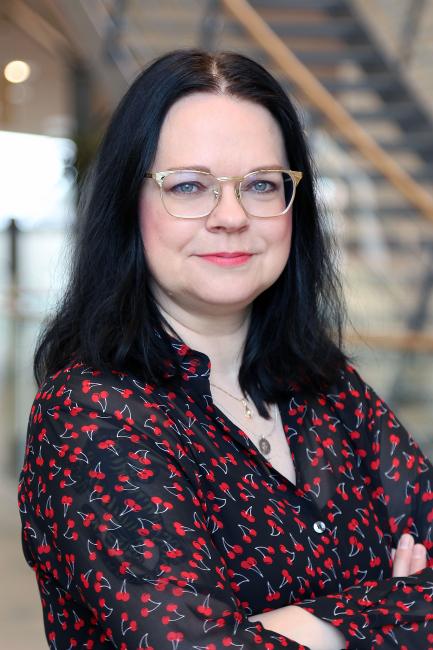Interview with Maria Moberg Stephenson
This interview is with Maria Moberg Stephenson, a Senior Lecturer in Social Work at Karlstad University. Maria’s research focuses on young people facing challenges like homelessness, migration, and social exclusion in Sweden. She is currently involved in several projects, including research on girls experiencing homelessness, girls in criminal gangs, and the challenges faced by street-level social workers. Using ethnographic methods, Maria’s work aims to capture the real-life experiences of the people she studies.
In this interview, we’ll talk about her current and past projects, how she connects with her participants, and the social impact of her work.

How did you first become interested in young people’s life situations, gender, and belonging, and how has that focus evolved?
I was doing ethnographic fieldwork in a creative youth organisation and spent a summer with some young girls. Some of them had quite difficult life situations and found a space for safety, community, and belonging in this organisation through the processes of creating, acting, dancing, and making music. This is where my interest in young girls’ life situations, and particularly their sense of belonging, started.
Later, I worked with young people who had migrated to Sweden without their parents. They navigated life in a new country without parental support, with demands to adapt to a certain “Swedishness,” while racist boundaries in society made all this more difficult. I found integration strategies in social work to be quite one-sided and not always suitable for individuals, which I wanted to explore further. I had the opportunity to do a PhD in Social Work, where I investigated NGO social work with unaccompanied youth. Belonging from different perspectives became the focus of my thesis.
After that, I received a grant with two colleagues to study teenage girls growing up in marginalised areas in Sweden. We focused on their life situations, sense of place, and orientations in everyday life. That’s when I really started seeing myself as a girlhood researcher. Most of my work now is with girls and young women, from critical and feminist perspectives.
Could you tell us about your current project on "Girls in Criminal Gangs"? What have you found particularly challenging in this research?
We’ve interviewed 26 girls and young women between the ages of 15 and 30 who are, or have been, involved in what media refers to as criminal gangs. We also spoke with 24 professionals who encounter these girls in their work. At first, I wasn’t sure we would even find participants — but it turned out the opposite. We actually met more girls than planned. Some even said explicitly that they wanted to be heard and hoped their experiences could help others.
We used life story interviews, which are long and in-depth. Many of the girls had experienced profound trauma — physical, psychological, and sexual abuse, often from parents or boyfriends, before and within the gang context. Taking in so many painful stories can be emotionally heavy. The most challenging thing for me is managing my anger about the often non-existent or inappropriate support these girls receive. They have been exposed to so much abuse at a young age, and I would say they are also violated by the state — either by receiving no help at all or by being offered support that is not suitable.
Your projects touch on complex and sensitive issues. How does this study impact your participants and you as a researcher?
All my research is about giving a voice to people — particularly girls and young women — who are rarely listened to. In the project about girls in criminal gangs, the girls participate because they want to share their life stories. They know they’re an overlooked group, even if youth in these contexts often are talked about by others. Many of them said that no one had cared about their perspectives before.
That makes the work worthwhile, even when the stories are hard to hear. For me, it's important to share participants’ perspectives. As long as I speak about what they’ve said and their own experiences, I can base everything on their voices. I also think it’s important to bring in a societal perspective — to visualise all the boundaries in society. In social work, these problems are often hidden, and, for instance, racial issues are reproduced without awareness. So it’s crucial to expose and discuss them.
How do you choose the methods for your research projects? What are the advantages and challenges of using ethnographic methods, especially when working with young disadvantaged people?
My research focuses on life situations and belonging, so I always look for qualitative methods that suit both the project and the participants. Ethnography is powerful for long-term engagement — but it’s not always feasible.
In the project on girls in criminal gangs, ethnography wouldn’t work. These are hard-to-reach participants, and we often only get one chance to meet. That’s why we used life story interviews — to hear as much as possible in one sitting. Each girl spoke with us for between one and three hours, sometimes a bit longer. They told us everything they wanted to about their lives in that one interview.
But in our upcoming project on girls experiencing homelessness, visual ethnography will be more suitable. These girls are largely invisible in Sweden — youth under 18 aren’t officially recognised as homeless. The idea is that they should receive support if they can’t live with their parents. But it’s not that simple. In reality, many young people are homeless. Where do they live? Sometimes with different friends, sometimes even in stairwells. It could be short-term or long-term. I met a girl in a previous project who was homeless for a year. She was supposed to live with her parent who abused her, so she kept running away and hiding to avoid being sent back.
We’ll invite participants to use photography, film, or drawing to share their everyday lives, even when we’re not present. This helps visualise their existence. Again, it’s about giving a voice to the girls themselves. Their active role in the project is very important. To gain better insight into their lives and build trust, we will also conduct regular participant observations with the same girls over a long period. The plan is for them to be involved from the start — taking photos or drawing their daily lives, which we’ll use in conversations and as research material. If they want to, they can also help produce the final output, which will be a photobook and an exhibition.
As we haven’t started the fieldwork yet, I can only guess what the challenges will be. One big one will be getting in contact with the girls, since there are no organisations specifically for young people who are homeless without their parents in Sweden. But we also thought it would be nearly impossible to find girls in criminal gangs — and yet we found 26 participants.
Your work often focuses on marginalised and vulnerable groups. How do you approach the ethical challenges of researching these groups? How do you ensure that your participants' voices are represented in your work?
Ethically, the most important is exactly that, that the participants’ own voices are in focus, and that it is not only someone else talking about them. For instance, in the project with girls growing up in marginalised areas, the girls participate also there just because they are never heard, even if youth in these areas often are talked about by others.
In the project about girls in homelessness, we will also ask if the girls themselves want to be involved in producing the end product which is a photobook and an exhibition.
Also, it is different for a girl to talk to us researchers than someone else. The girls in criminal gangs for instance, most other people they talk to may take their information further, but with us, they know that they are anonymous and that we will only write about their experiences. Not talk to the police or social services about them. That is very important, ethically.
What kind of knowledge do you think your research contributes to social work practices?
This research brings in voices that hardly never been heard before. Girls in criminal gangs are beginning to be acknowledged, but for a long time, they were completely invisible — even to professionals. Their life stories reveal repeated abuse, often starting at home — physical, sexual, and psychological abuse from parents and/or boyfriends — which precedes their involvement in crime.
Once in a criminal context, they often face further abuse but also find a sense of belonging that they never had before. Sweden tends to compartmentalise support: if a girl is abused by her boyfriend, she goes to a women’s shelter; if she commits a crime, she receives criminal rehabilitation; if she has mental health problems, she sees a psychologist. But most of these girls need all of that — simultaneously.
Some need new homes due to threats or having no family to return to. The current system is too narrow and fragmented. We need to understand the complexity of their lives and provide integrated support.
What role does interdisciplinary work play in understanding complex social issues like migration and belonging?
I think it is very important. Myself is a social anthropologist, with a PhD in Social Work. I tackle social issues and social work from a critical angle. Belonging for instance, it is a complicated concept, as how someone creates a sense of belonging may not be the same as perceptions in society on belonging. This is evident in all my research really. In our team, we have backgrounds in social anthropology, gender studies, criminology, and social work. These perspectives help us see the complexity.
Individuals such as non-white and non-Swedish, or girls within a criminal context, are not fitting in when looking at who is seen as belonging within Swedish society. While girls in criminal gangs often find belonging in a criminal group when they never felt belonging growing up in an abusive context. Issues such as gender, race, and class are often evident in this and the boundaries in society, and it is important with interdisciplinary work to tackle these issues.
Are there any recent publications or ongoing projects you’d like to highlight?
Yes, I recently published an article on the impact of neoliberal logic and ideas of establishment in Sweden on NGO social work with asylum-seeking young people. Together with three other researchers from different universities, I’m co-editing an anthology about migration, racialisation processes, ethnic relations, and social justice in a Swedish context. The book is intended for undergraduate students across various disciplines and is planned for publication next year.
Also, together with Wibke Straube from Gender Studies and Matilda Wurm from Social Work at Örebro University, we received funding from SLU last year to work on a research application about LBTIQ+ youth in rural areas in Sweden. We are currently developing that project.
The interview was carried out by Anna Pechurina, June 2025

